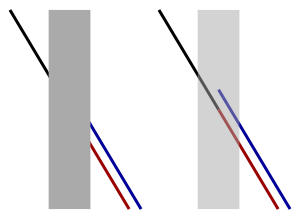
Poggendorff illusion
Encyclopedia

Johann Christian Poggendorff
Johann Christian Poggendorff , was a German physicist born in Hamburg.By far the greater and more important part of his work related to electricity and magnetism. Poggendorff is known for his electrostatic motor which is analogous to Wilhelm Holtz's electrostatic machine...
, the editor of the journal, who discovered it in the figures Johann Karl Friedrich Zöllner
Johann Karl Friedrich Zöllner
Johann Karl Friedrich Zöllner was a German astrophysicist who studied optical illusions. He invented the Zöllner illusion where lines that are parallel appear diagonal. The lunar Zöllner crater is named in his honor...
submitted when first reporting on what is now known as the Zöllner illusion
Zollner illusion
The Zöllner illusion is a classic optical illusion named after its discoverer, German astrophysicist Johann Karl Friedrich Zöllner. In 1860, Zöllner sent his discovery in a letter to physicist and scholar Johann Christian Poggendorff, editor of Annalen der Physik und Chemie, who subsequently...
, in 1860.
In the picture to the right, a straight black and red line is obscured by a grey rectangle. The blue line, rather than the red line, appears to be a continuation of the black one, which is clearly shown not to be the case on the second picture. Instead there is an apparent position shift of the lower portion of the line. The magnitude of the illusion depends on the properties of the obscuring pattern and the nature of its borders.
Many detailed studies of the illusion, including "amputating" various components
point to its principal cause: acute angles in the figure are seen by viewers as expanded though the illusion diminishes or disappears when the transverse line is horizontal or vertical. Other factors are involved.

